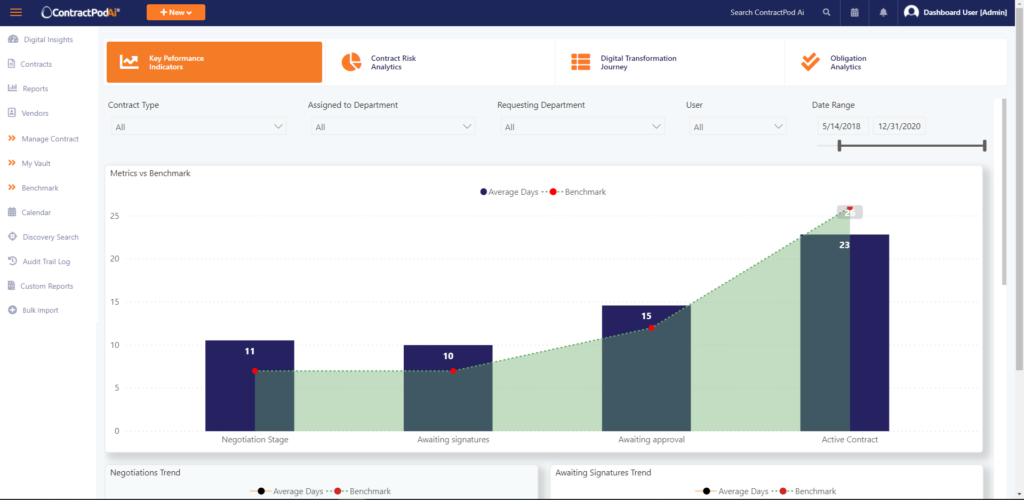
ContractPodAi, the NLP-powered contract lifecycle management platform, has launched a new dashboard for inhouse legal teams that shows the current state of their contracts through a variety of perspectives: from risk profiles, to obligations, to the use of esignatures, to KPIs, and more.
The dashboard, branded Legal DeepSights, also allows GCs to build their ‘own metrics-based team goals’. Meanwhile having this data visibility (see images below) makes it a lot easier, it is hoped, for senior inhouse lawyers to show their employers – and themselves – objective information about how they are performing and helping the company.
One of the challenges that contributes to the inhouse team’s traditional distance from the business it serves is that it’s hard to actually show what you are doing – unless you have some means of digitally collating where you are with the company’s contracts and then showing what that actually means in practical terms.
So, what does it show? Legal DeepSights is divided into four main areas:
- ‘Key Performance Indicators: Insight into how well a legal team is performing against their individualised team goals and desired business outcomes, including tracking improvement against their own benchmarks over time.
- Digital Transformation Journey: A detailed view of an organisation’s adoption of and impact from technology. (Showing where using esignatures, or AI review, for example).
- Contract Risk Analytics: A risk profile of a company’s contract portfolio, including drivers of risk and how to reduce the risk.
- Obligation Analytics: A window into the obligations and metadata across all contracts, with options to filter and specify down to key sub-groups of contracts (e.g., by supplier, customer).’


As seen above, this is not just a massive list of all of the contracts. It’s showing things like how many contracts are awaiting signature, or what obligations you have e.g. related to indemnity clauses, or how overall the legal team is doing in terms of staying on top of its targets by showing how often certain types of action are occurring, e.g. what is the average time for the inhouse team to approve a contract?
And it also shows things like what is the range of governing laws across your contract stack, as well as showing the risk profile across the company’s contracts (see image below).

In short, the team at ContractPodAi have thought about all the daily concerns of a GC and what they can do to surface information in a simple and clear way to allow them to sleep better at night.
It also reflects a growing trend for better UI and UX across legal tech, with the goal of making lawyers’ lives easier with accessible information presented in ways you might find in consumer applications, e.g. health apps.
Sarvarth Misra, CEO of ContractPodAi, said: ‘What we want is GCs to come out as leaders of digital transformation in their organisations, leaders who really measure the success of their own transformation journey with meaningful metrics. We firmly believe this will address any scepticism surrounding digital transformation in the legal space.’
It won’t of course be the first company to create a dashboard to provide ongoing insights into a contract stack. Knowable, which spun out of Axiom, has also developed one – although it’s still evolving. And companies such as Juro have for some time now sought to help clients tap data from their contracting platform to enable them to better understand their contracts. Plus, ThoughtRiver has pioneered the area of risk assessment in contracts.
That said, what ContractPodAi has launched is a very comprehensive and multi-faceted dashboard that brings together all in one place what several companies have done in isolation.
Of course, the penultimate point here is that such dashboards are only as good as the data that goes into them. However, ContractPodAi, through its use of NLP tech and teams of human reviewers is able to handle the onboarding of contract data for you, rather than you having a dashboard provided by one party and the filleting of the contracts to get to the data then provided by another party.
Final point is: having the data is a great start, but GCs then have to make use of it and they also need to get a sense of ‘what is normal?‘. I.e. you may have a dashboard now that shows what is happening inside your inhouse team, but what does ‘good’ look like?
This raises all kinds of interesting issues, such as maybe getting companies around the world to share their KPIs so that GCs can benchmark where they should be. That in turn becomes a powerful motivator for driving change in how the legal team operates.
But, this is a good start, as the immortal words say: you can’t change what you don’t measure.